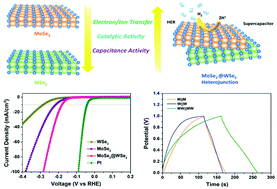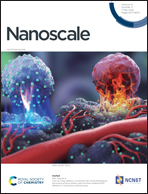Synergistic 2D MoSe2@WSe2 nanohybrid heterostructure toward superior hydrogen evolution and flexible supercapacitor†
Abstract
Two-dimensional (2D) transition metal dichalcogenide (TMDC) heterostructure is a new age strategy to achieve high electrocatalytic activity and ion storage capacity. The less complex and cost-effective applicability of the large-area TMDC heterostructure (HS) for energy applications require more research. Herein, we report the MoSe2@WSe2 nanohybrid HS electrocatalyst prepared using liquid exfoliated nanocrystals, followed by direct electrophoretic deposition (EPD). The improved catalytic activity is attributed to the exposure of catalytic active sites on the edge of nanocrystals after liquid exfoliation and the synergistic effect arises at HS interfaces between the MoSe2 and WSe2 nanocrystals. As predicted, the HS catalyst achieves a lower overpotential of 158 mV, a smaller Tafel slope of 46 mV dec−1 for a current density of 10 mA cm−2, and is stable for a long time. The flexible symmetric supercapacitor (FSSC) based on the HS catalyst demonstrates the excellent specific capacitance (Csp) of 401 F g−1 at 1 A g−1, 97.20% capacitance retention after 5000 cycles and high flexible stability over 1000 bending cycles. This work presents a less complex and solution-processed efficient catalyst for future electrochemical energy applications.

- This article is part of the themed collection: Nanoscale Most Popular 2022 Articles


 Please wait while we load your content...
Please wait while we load your content...